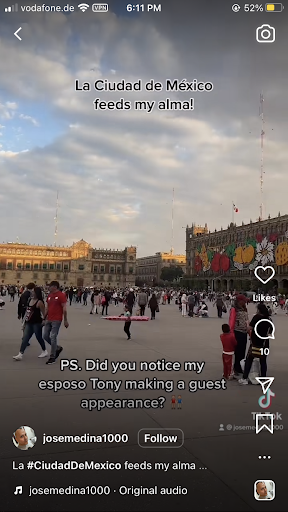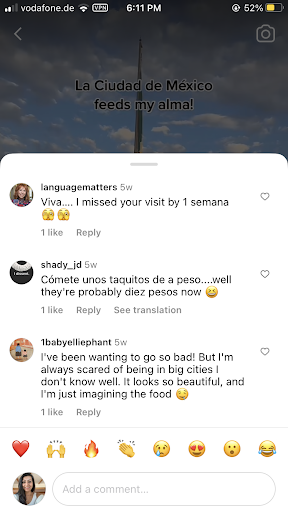Learning a new language isn't a question of leaving one language behind in order to use the new one—language learning is about adding new ways of expressing ourselves!
Multilingual people—including those learning to be multilingual—use their languages in clever, complex ways. We call this communication translanguaging.
What is translanguaging?
Translanguaging is a way of understanding communication and getting your message across by using all your resources! We're used to thinking about "language" as one specific thing, with a lot of rules about what counts as that language and what doesn't, but in fact the divisions between one language and another aren't so clear. And they also don't represent how people actually use language!
When you've got something you want to communicate, you want to express it as quickly and accurately as possible. You've got something to say! Imagine the current of a flowing river: It doesn't stop because there's a rock in its path—it just flows.
It's the same with all our languages: new languages we're learning, languages we know well, and languages we feel a little hesitant about using. When we have something we want to express, we don't have to stick to only "named" languages (like what we think of as being "real English" or "real Spanish") or even only one language. This translanguaging helps you get around any rocks in your path!
What are examples of translanguaging?
Check out this example of the singer Selena Quintanilla translanguaging during an interview. Selena was a bilingual speaker of English and Spanish who grew up along the Texas-Mexico border, a place where both languages have been used for centuries. In the interview, Selena uses Spanish and English to communicate with the interviewer—and he uses both, too! Her translanguaging shows her Mexican-American identity and reflects how language is used in the places that she (and the reporter!) come from. Look for how he references a telenovela that Selena acted in!

Kali Uchis is another great example of someone who does this in her music! She was born in the U.S. and spent a lot of time with her dad’s family in Colombia. She speaks English and Spanish to herself—listen to her songs "Malvada" and "Telepatía" to hear it for yourself!
Learners can practice this in their communication too—and for many of the same reasons that other multilinguals translanguage! You can translanguage if you haven't learned a word or expression in your new language yet or because one language just gets your point across better than another.
Is translanguaging the same as Spanglish?
You're probably already familiar with some kinds of language mixing that go by different names! Translanguaging is the umbrella for all of them:
Code-switching
This is when people move between different languages or dialects in the same conversation. One word or sentence might be in one language, and other words or sentences might be in another. (For Spanish and English, you might have heard this called "Spanglish"!)
Translation
Everything can be translated but sometimes using one language or another can feel more efficient or can convey emotions and context more exactly. Multilinguals can also have fun with translation between languages by intentionally using one translation or literal translations with others who know both languages.
Bilingualism and biliteracy
These terms describe two languages being brought together in a society or through education. Multilingual students are learning how to navigate many communities and information in multiple languages, and they are developing their own language identity, too!
What should learners know about translanguaging?
Translanguaging enables you to contribute and be an active member of all your learning communities no matter the language—and no matter your language proficiency! You can use it at any level, which really helps you start using your new language right away. For example, you can participate in forums that talk about your favorite hobbies, write songs, or comment on TikTok videos or Instagram posts using all the language tools at your disposal!

|

|
What should teachers know about translanguaging?
In school settings, students come with a wealth of knowledge that they can’t share if they are limited to monolingual classrooms. The more we can allow learners of all ages to engage in translanguaging, the more literacy power we can unlock inside all of them!
If you are a teacher that has multilingual learners in your classroom, challenge yourself to think about the messages you are sending your students with the ways in which you talk about their native languages. Reflect on your own language use and language practices and then get to know your students and their practices better!
Try these out:
- Ask your students about their language use. What languages do they speak? When? With whom?
- Ask students about their school experiences. What was the school system like in their country of origin? How does that compare or contrast to their experiences now?
- Assess student literacy in their first language and create opportunities for students to develop literacy skills in their first language. This may mean filling in gaps they may have if they are students with interrupted education (SIFE) or late entrant newcomers (students from another country that enter the school year after it has started). Use translanguaging to scaffold meaning as your students learn to communicate in new ways!
- Create multimodal exposures to content and connect it to their lives. Be sure to enable students to use their full linguistic repertoire to ask and answer questions, make comments, and participate.
- And my personal favorite: Encourage students to participate using their full linguistic repertoire to establish a space where their language practices are acknowledged and are the norm, not an exception.
For more information about translanguaging and classroom practices, check out Dr. Ofelia Gacia’s research and resources!
Translanguaging is a verb—it's something we do!
Be proud of the many ways you can express yourself, including in a language you are learning! Instead of focusing on skills or vocabulary you're still developing, think of the new community you're a part of. Translanguaging can help you build skills and get your message across—others won’t judge you, and instead, they will be happy you are trying!



